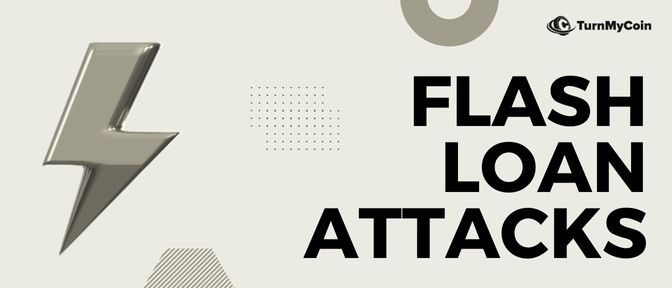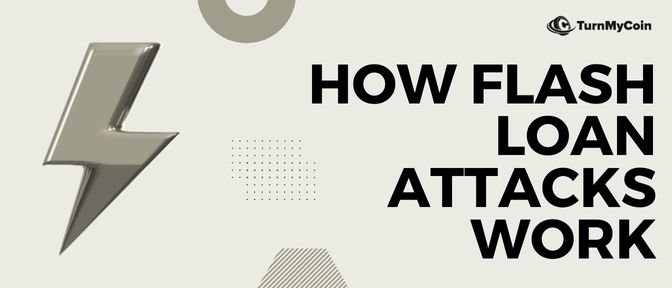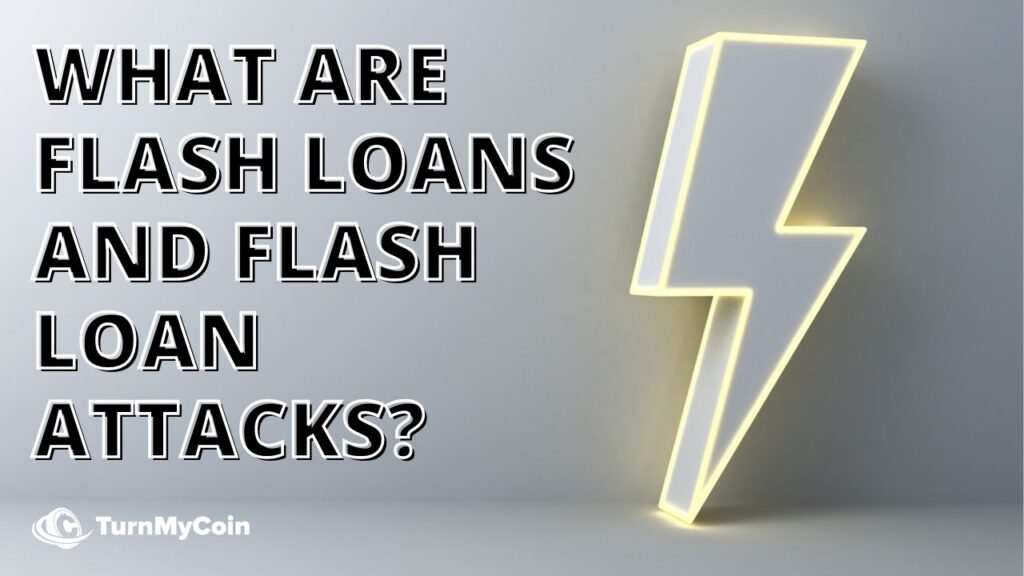Introduction
The increasing interest in cryptocurrency has led to a growing number of opportunities for decentralized finance, or DeFi, in the future. The goal of DeFi is to create a decentralized, transparent, and permissionless financial ecosystem using blockchain networks.

However, as we’ve seen in the past, there is an ugly side to DeFi.
For Example, the Binance Smart Chain (BSC) protocol PancakeBunny suffered a catastrophic $200m flash loan vulnerability attack. Which results in the loss of over 700,000 BUNNY and 114,000 BNB tokens.
Flash loan attacks are becoming a significant problem in the cryptocurrency and DeFi space. In this article, we will understand
- What is a Flash Loan?
- What is Flash a Loan Attack?
- Why they pose a serious threat to the DeFi industry.
What are Flash Loans – Flash loan Crypto?

Flash loans have become a popular topic in the cryptocurrency world, especially within the realm of decentralized finance (DeFi).
In essence, a flash loan is a type of uncollateralized loan that is issued and repaid within a single blockchain transaction on a DEX (Decentralized Exchange) or a lending platform, making it fast and flexible.
Unlike traditional loans, flash loans don’t require borrowers to put up any collateral or go through a credit check. Instead, they use the borrower’s smart contract as collateral, with the loan amount and fee deducted from the transaction’s profits.
The borrower can use the flash loan to quickly execute a trade or a series of trades to take advantage of market opportunities. Once the trades are executed, the borrower repays the loan along with a fee, all within the same transaction.
This makes it a convenient option for those looking to take advantage of arbitrage opportunities, execute complex trades or perform other financial operations within the DeFi ecosystem. One of the main benefits of flash loans is their accessibility.
Anyone with an internet connection can access and use them, without needing to go through a traditional financial institution or undergo any credit checks.
This feature has made flash loans particularly attractive to crypto traders and speculators, who can leverage them to maximize their profits or mitigate their losses.

However, flash loans also come with some inherent risks. They are susceptible to hacks and exploits, as seen in various high-profile attacks that have resulted in substantial losses.
These attacks are often carried out by exploiting vulnerabilities in the smart contract code of DeFi protocols, highlighting the importance of security in the DeFi space.
What Is a Flash Loan Attack?

A flash loan attack is a type of exploit that takes advantage of the decentralized nature of some cryptocurrency lending platforms to manipulate prices or steal funds.
These loans allow users to borrow large sums of cryptocurrency without collateral. But they must be repaid in full within a single transaction block, which typically lasts less than 15 seconds.
Flash loan attacks occur when a hacker uses a flash loan to exploit vulnerabilities in a DeFi protocol. The hacker borrows a large sum of cryptocurrency, typically in the form of stablecoins.
Then executes a series of transactions designed to manipulate the price of a particular cryptocurrency. Once the price has been manipulated to the hacker’s advantage, the hacker repays the flash loan and pockets the profits.
Flash loan attacks are particularly dangerous because they can happen quickly, with the hacker borrowing and repaying the loan in a matter of seconds.
This makes it difficult for security protocols to detect and prevent such attacks.
Furthermore, the anonymous nature of blockchain transactions makes it difficult to trace and recover stolen funds.
Flash loan attacks have become a significant problem in the DeFi space, with several high-profile attacks occurring in recent months. In February 2021, the DeFi protocol bZx lost $55 million in a flash loan attack.
In April 2022, the DeFi platform Aave suffered a $182 million loss due to a flash loan attack on the Beanstalk Farms stablecoin protocol.
While DeFi has the potential to revolutionize the financial industry, it is essential to address the security concerns associated with flash loan attacks to ensure the long-term success of the DeFi industry.
How Flash Loan Attacks Work?

Flash loan attacks have become a growing concern in the world of cryptocurrency and decentralized finance. These attacks exploit vulnerabilities in smart contracts to manipulate financial transactions and steal funds without putting up any collateral.
Flash loan attacks can take many forms, but some common examples include:
1. Price manipulation
In this type of attack, the attacker uses a flash loan to purchase a large amount of a specific cryptocurrency on one exchange, causing the price to rise. The attacker then sells the cryptocurrency on another exchange where the price is higher, making a profit.
Let me explain, The attacker first borrows a large sum of cryptocurrency from a flash loan provider, which is typically a decentralized lending platform. They then use the borrowed funds to manipulate the price of a particular cryptocurrency or asset, often using techniques such as arbitrage or market manipulation.
Once the price has been artificially inflated, the attacker sells the asset at a profit and repays the loan, pocketing the difference. One of the key features of flash loan attacks is that they require no collateral, making them a low-risk and high-reward method for attackers to profit from cryptocurrency.

2. Liquidity pool manipulation
Some decentralized exchanges use liquidity pools to facilitate trades. Attackers can use flash loans to manipulate the price of a cryptocurrency in a liquidity pool, allowing them to make a profit by buying low and selling high.
3. Reentrancy attacks
This type of attack exploits a vulnerability in the smart contract of a decentralized lending platform. The attacker uses a flash loan to borrow cryptocurrency and then repeatedly withdraws funds from the platform, tricking it into providing more funds than it actually has.
Flash loan attacks can be difficult to prevent because they are executed quickly and do not require collateral. To mitigate the risk of flash loan attacks, some lending platforms have implemented safeguards such as limiting the amount of cryptocurrency that can be borrowed in a single flash loan or requiring borrowers to go through a verification process.
What are Flash Loans And How Do I Prevent a Flash Loan Attack?

Flash loan attacks have become a significant concern for the DeFi industry. While it’s difficult to predict when such attacks will occur, there are several steps that you can take to reduce your risk of becoming a victim. Here are some of the strategies you can use to prevent flash loan attacks:
1. Use reputable and audited DeFi platforms
One of the best ways to minimize your risk of flash loan attacks is to use DeFi platforms that have a good reputation and have undergone independent security audits. Audits help ensure that the platform’s code is safe, and vulnerabilities are identified and addressed.
2. Avoid untested and unaudited platforms
Unaudited and untested DeFi platforms can be highly susceptible to attacks. It’s recommended that you avoid them or use them cautiously until they have undergone a proper security audit.
3. Limit your borrowing
Borrowing a large sum of money through a DeFi platform. Which can make you a more attractive target for flash loan attackers. To avoid this, consider borrowing a smaller amount of money that you can easily repay.
By doing so, you reduce the potential gains for attackers, making them less likely to target you.
4. Monitor your accounts regularly
Keeping a close eye on your accounts can help you identify any suspicious activity early. If you notice any unauthorized withdrawals or transfers, take action immediately to protect your funds.
5. Diversify your investment
Diversifying your investments across different DeFi platforms can reduce your overall risk of loss. By spreading your investments, you decrease the impact of a single platform’s attack on your portfolio.

6. Use smart contract insurance
Smart contract insurance is a relatively new product that offers protection against flash loan attacks. These products are designed to cover losses resulting from vulnerabilities in smart contracts. Including those that are exploited in flash loan attacks.
7. Be cautious when executing transactions
Finally, it’s crucial to exercise caution when executing transactions on DeFi platforms. Make sure to double-check the transaction details, such as the recipient address, before confirming the transaction. Verify that the address is correct, and never execute a transaction if you’re unsure about its legitimacy.
Conclusion
Flash loan attacks are becoming increasingly common in the world of decentralized finance (DeFi). Morever, there are no signs of them slowing down anytime soon.
While many solutions have been proposed. Tt’s important to remember that DeFi technology is still in its early stages and vulnerabilities are constantly being exposed by hackers. This means that developers need to be vigilant and always ready to adapt and improve their solutions in response to new attacks.
However, users should not be deterred from participating in DeFi schemes like staking, yield farming, and liquidity mining, which offer many exciting opportunities. Despite the risks posed by flash loans.
There are other DeFi lending protocols available, and users can find the best DeFi lending protocols across chains with a little research.


